Holmes Institute HA3032 Auditing: Auswide Bank Audit Report Analysis
VerifiedAdded on 2023/03/20
|6
|1433
|54
Report
AI Summary
This auditing report provides a detailed analysis of Auswide Bank's financial performance, focusing on key financial ratios and materiality. The report begins with an introduction to analytical procedures, explaining their role in understanding the client's business and identifying potential risk areas. It then delves into a ratio analysis of Auswide Bank, including Return on Assets (ROA), Return on Equity (ROE), Net Interest Margin (NIM), and Capital Adequacy Ratio (CAR), with data from 2016 to 2018. Each ratio is calculated and discussed, highlighting trends and implications for the bank. The report also addresses the calculation of materiality, a crucial aspect of auditing, determining the threshold for misstatements. It concludes with the materiality calculation for Auswide Bank, based on profit before income tax expense, and explains the rationale behind the chosen percentage and benchmark. The report aims to provide a comprehensive overview of the audit process and financial analysis relevant to Auswide Bank, offering insights into its financial health and risk assessment.
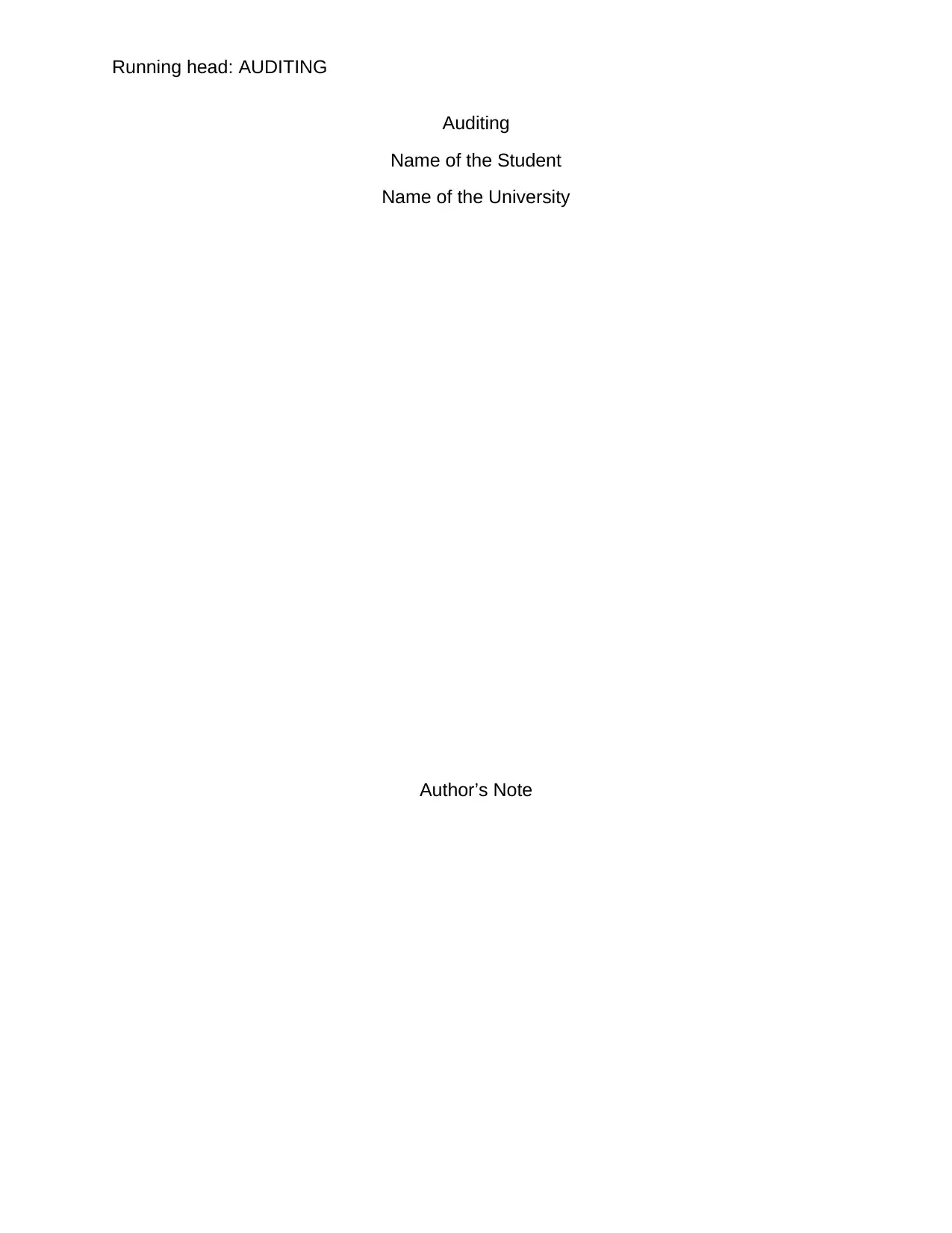
Running head: AUDITING
Auditing
Name of the Student
Name of the University
Author’s Note
Auditing
Name of the Student
Name of the University
Author’s Note
Paraphrase This Document
Need a fresh take? Get an instant paraphrase of this document with our AI Paraphraser
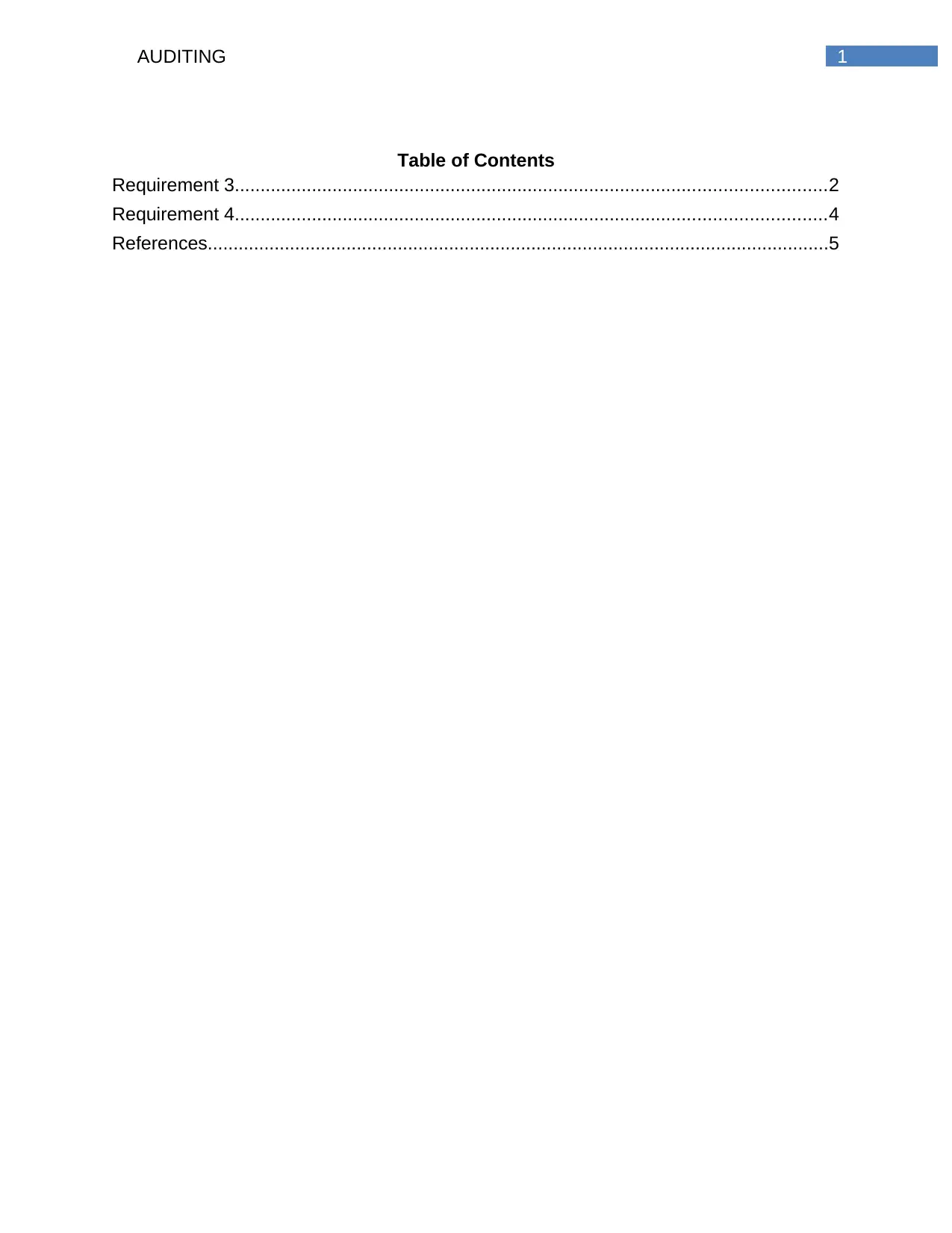
1AUDITING
Table of Contents
Requirement 3...................................................................................................................2
Requirement 4...................................................................................................................4
References.........................................................................................................................5
Table of Contents
Requirement 3...................................................................................................................2
Requirement 4...................................................................................................................4
References.........................................................................................................................5
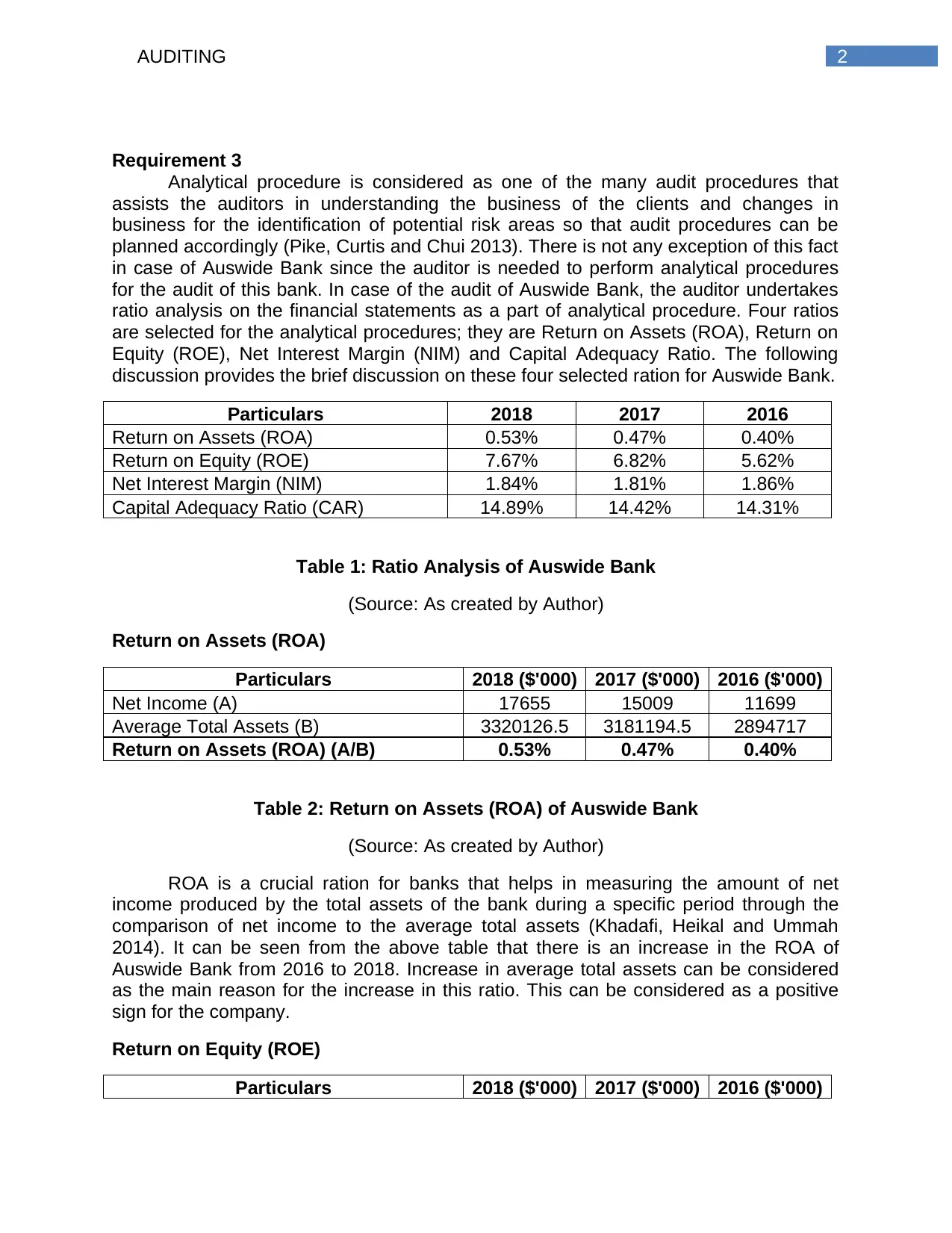
2AUDITING
Requirement 3
Analytical procedure is considered as one of the many audit procedures that
assists the auditors in understanding the business of the clients and changes in
business for the identification of potential risk areas so that audit procedures can be
planned accordingly (Pike, Curtis and Chui 2013). There is not any exception of this fact
in case of Auswide Bank since the auditor is needed to perform analytical procedures
for the audit of this bank. In case of the audit of Auswide Bank, the auditor undertakes
ratio analysis on the financial statements as a part of analytical procedure. Four ratios
are selected for the analytical procedures; they are Return on Assets (ROA), Return on
Equity (ROE), Net Interest Margin (NIM) and Capital Adequacy Ratio. The following
discussion provides the brief discussion on these four selected ration for Auswide Bank.
Particulars 2018 2017 2016
Return on Assets (ROA) 0.53% 0.47% 0.40%
Return on Equity (ROE) 7.67% 6.82% 5.62%
Net Interest Margin (NIM) 1.84% 1.81% 1.86%
Capital Adequacy Ratio (CAR) 14.89% 14.42% 14.31%
Table 1: Ratio Analysis of Auswide Bank
(Source: As created by Author)
Return on Assets (ROA)
Particulars 2018 ($'000) 2017 ($'000) 2016 ($'000)
Net Income (A) 17655 15009 11699
Average Total Assets (B) 3320126.5 3181194.5 2894717
Return on Assets (ROA) (A/B) 0.53% 0.47% 0.40%
Table 2: Return on Assets (ROA) of Auswide Bank
(Source: As created by Author)
ROA is a crucial ration for banks that helps in measuring the amount of net
income produced by the total assets of the bank during a specific period through the
comparison of net income to the average total assets (Khadafi, Heikal and Ummah
2014). It can be seen from the above table that there is an increase in the ROA of
Auswide Bank from 2016 to 2018. Increase in average total assets can be considered
as the main reason for the increase in this ratio. This can be considered as a positive
sign for the company.
Return on Equity (ROE)
Particulars 2018 ($'000) 2017 ($'000) 2016 ($'000)
Requirement 3
Analytical procedure is considered as one of the many audit procedures that
assists the auditors in understanding the business of the clients and changes in
business for the identification of potential risk areas so that audit procedures can be
planned accordingly (Pike, Curtis and Chui 2013). There is not any exception of this fact
in case of Auswide Bank since the auditor is needed to perform analytical procedures
for the audit of this bank. In case of the audit of Auswide Bank, the auditor undertakes
ratio analysis on the financial statements as a part of analytical procedure. Four ratios
are selected for the analytical procedures; they are Return on Assets (ROA), Return on
Equity (ROE), Net Interest Margin (NIM) and Capital Adequacy Ratio. The following
discussion provides the brief discussion on these four selected ration for Auswide Bank.
Particulars 2018 2017 2016
Return on Assets (ROA) 0.53% 0.47% 0.40%
Return on Equity (ROE) 7.67% 6.82% 5.62%
Net Interest Margin (NIM) 1.84% 1.81% 1.86%
Capital Adequacy Ratio (CAR) 14.89% 14.42% 14.31%
Table 1: Ratio Analysis of Auswide Bank
(Source: As created by Author)
Return on Assets (ROA)
Particulars 2018 ($'000) 2017 ($'000) 2016 ($'000)
Net Income (A) 17655 15009 11699
Average Total Assets (B) 3320126.5 3181194.5 2894717
Return on Assets (ROA) (A/B) 0.53% 0.47% 0.40%
Table 2: Return on Assets (ROA) of Auswide Bank
(Source: As created by Author)
ROA is a crucial ration for banks that helps in measuring the amount of net
income produced by the total assets of the bank during a specific period through the
comparison of net income to the average total assets (Khadafi, Heikal and Ummah
2014). It can be seen from the above table that there is an increase in the ROA of
Auswide Bank from 2016 to 2018. Increase in average total assets can be considered
as the main reason for the increase in this ratio. This can be considered as a positive
sign for the company.
Return on Equity (ROE)
Particulars 2018 ($'000) 2017 ($'000) 2016 ($'000)
⊘ This is a preview!⊘
Do you want full access?
Subscribe today to unlock all pages.

Trusted by 1+ million students worldwide
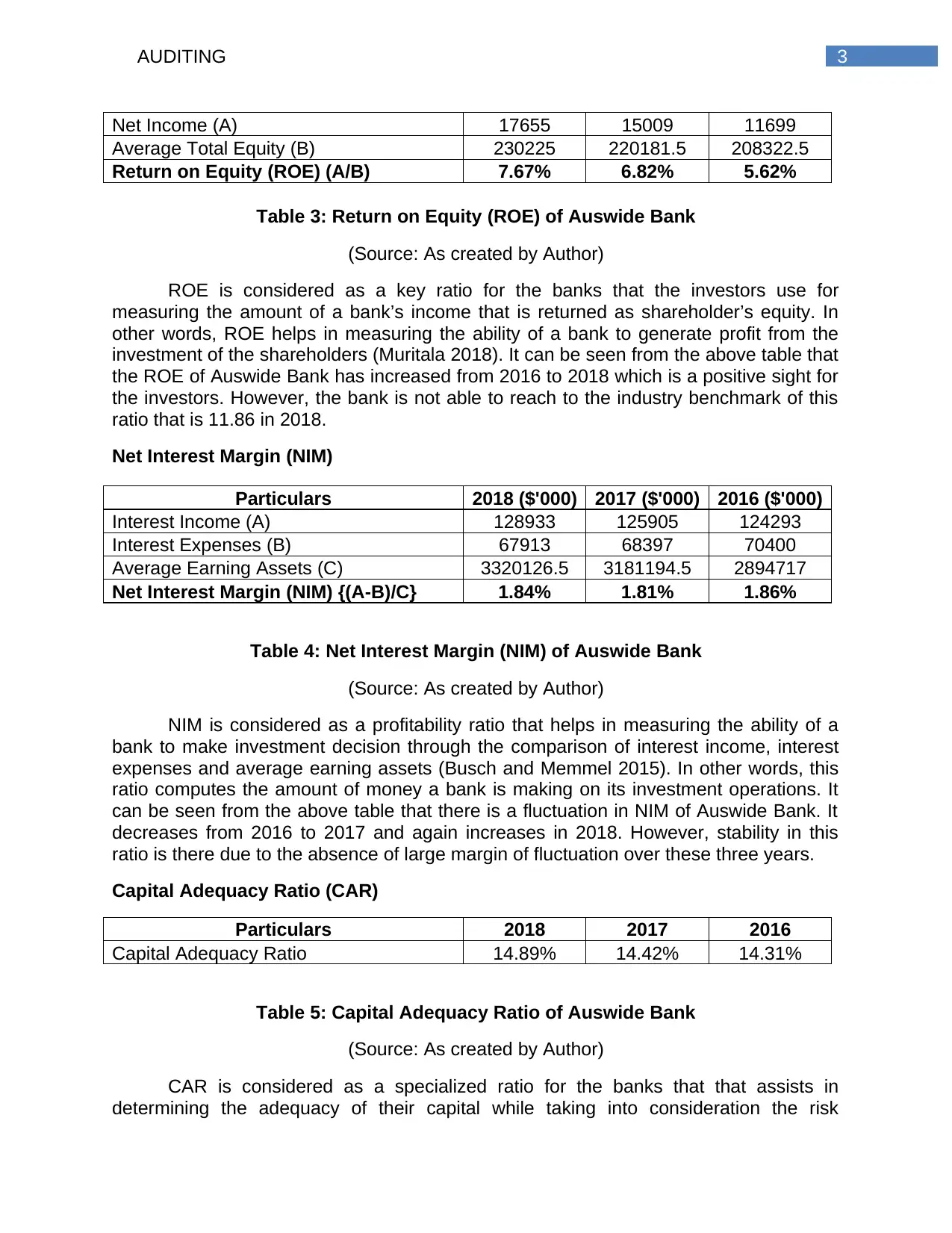
3AUDITING
Net Income (A) 17655 15009 11699
Average Total Equity (B) 230225 220181.5 208322.5
Return on Equity (ROE) (A/B) 7.67% 6.82% 5.62%
Table 3: Return on Equity (ROE) of Auswide Bank
(Source: As created by Author)
ROE is considered as a key ratio for the banks that the investors use for
measuring the amount of a bank’s income that is returned as shareholder’s equity. In
other words, ROE helps in measuring the ability of a bank to generate profit from the
investment of the shareholders (Muritala 2018). It can be seen from the above table that
the ROE of Auswide Bank has increased from 2016 to 2018 which is a positive sight for
the investors. However, the bank is not able to reach to the industry benchmark of this
ratio that is 11.86 in 2018.
Net Interest Margin (NIM)
Particulars 2018 ($'000) 2017 ($'000) 2016 ($'000)
Interest Income (A) 128933 125905 124293
Interest Expenses (B) 67913 68397 70400
Average Earning Assets (C) 3320126.5 3181194.5 2894717
Net Interest Margin (NIM) {(A-B)/C} 1.84% 1.81% 1.86%
Table 4: Net Interest Margin (NIM) of Auswide Bank
(Source: As created by Author)
NIM is considered as a profitability ratio that helps in measuring the ability of a
bank to make investment decision through the comparison of interest income, interest
expenses and average earning assets (Busch and Memmel 2015). In other words, this
ratio computes the amount of money a bank is making on its investment operations. It
can be seen from the above table that there is a fluctuation in NIM of Auswide Bank. It
decreases from 2016 to 2017 and again increases in 2018. However, stability in this
ratio is there due to the absence of large margin of fluctuation over these three years.
Capital Adequacy Ratio (CAR)
Particulars 2018 2017 2016
Capital Adequacy Ratio 14.89% 14.42% 14.31%
Table 5: Capital Adequacy Ratio of Auswide Bank
(Source: As created by Author)
CAR is considered as a specialized ratio for the banks that that assists in
determining the adequacy of their capital while taking into consideration the risk
Net Income (A) 17655 15009 11699
Average Total Equity (B) 230225 220181.5 208322.5
Return on Equity (ROE) (A/B) 7.67% 6.82% 5.62%
Table 3: Return on Equity (ROE) of Auswide Bank
(Source: As created by Author)
ROE is considered as a key ratio for the banks that the investors use for
measuring the amount of a bank’s income that is returned as shareholder’s equity. In
other words, ROE helps in measuring the ability of a bank to generate profit from the
investment of the shareholders (Muritala 2018). It can be seen from the above table that
the ROE of Auswide Bank has increased from 2016 to 2018 which is a positive sight for
the investors. However, the bank is not able to reach to the industry benchmark of this
ratio that is 11.86 in 2018.
Net Interest Margin (NIM)
Particulars 2018 ($'000) 2017 ($'000) 2016 ($'000)
Interest Income (A) 128933 125905 124293
Interest Expenses (B) 67913 68397 70400
Average Earning Assets (C) 3320126.5 3181194.5 2894717
Net Interest Margin (NIM) {(A-B)/C} 1.84% 1.81% 1.86%
Table 4: Net Interest Margin (NIM) of Auswide Bank
(Source: As created by Author)
NIM is considered as a profitability ratio that helps in measuring the ability of a
bank to make investment decision through the comparison of interest income, interest
expenses and average earning assets (Busch and Memmel 2015). In other words, this
ratio computes the amount of money a bank is making on its investment operations. It
can be seen from the above table that there is a fluctuation in NIM of Auswide Bank. It
decreases from 2016 to 2017 and again increases in 2018. However, stability in this
ratio is there due to the absence of large margin of fluctuation over these three years.
Capital Adequacy Ratio (CAR)
Particulars 2018 2017 2016
Capital Adequacy Ratio 14.89% 14.42% 14.31%
Table 5: Capital Adequacy Ratio of Auswide Bank
(Source: As created by Author)
CAR is considered as a specialized ratio for the banks that that assists in
determining the adequacy of their capital while taking into consideration the risk
Paraphrase This Document
Need a fresh take? Get an instant paraphrase of this document with our AI Paraphraser
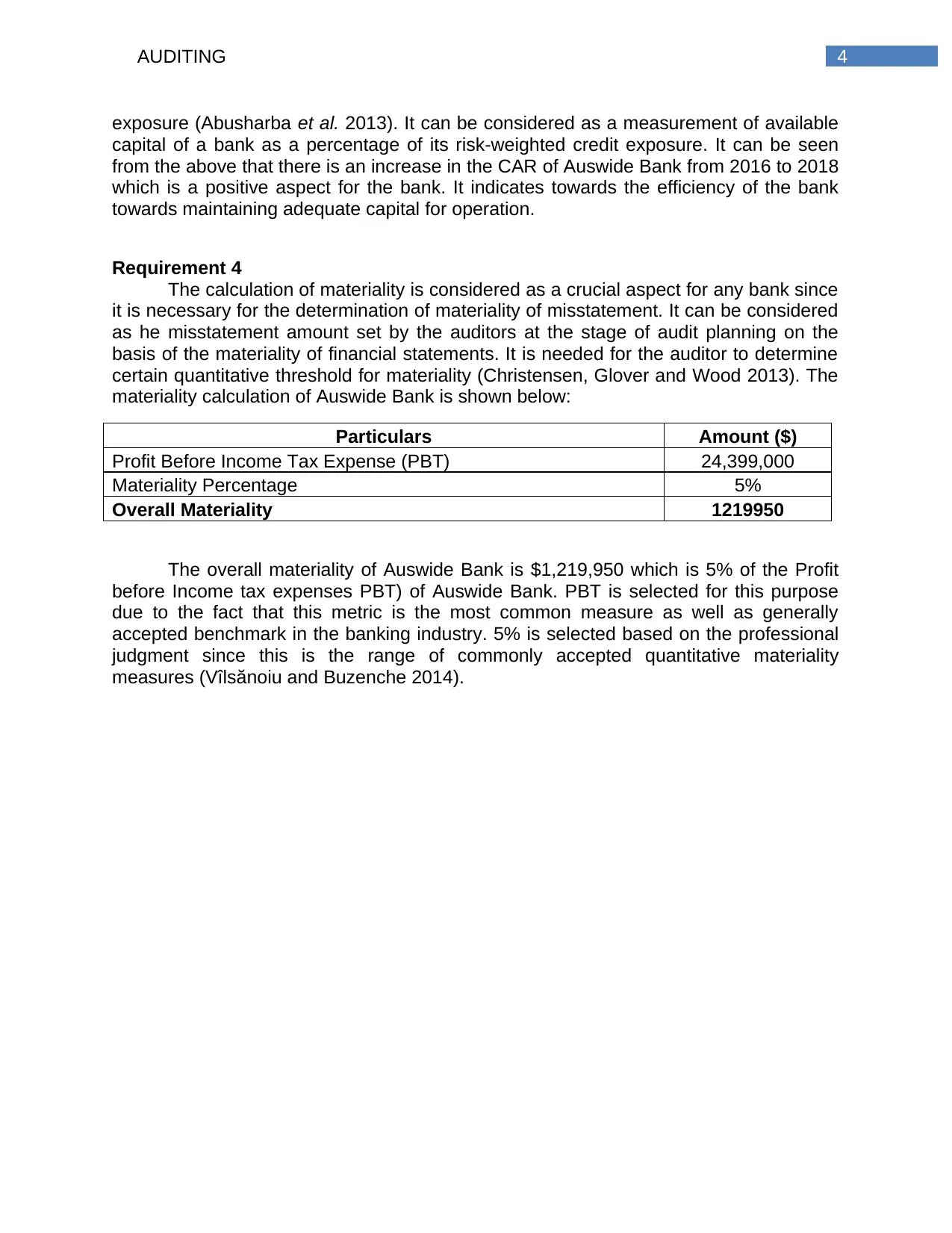
4AUDITING
exposure (Abusharba et al. 2013). It can be considered as a measurement of available
capital of a bank as a percentage of its risk-weighted credit exposure. It can be seen
from the above that there is an increase in the CAR of Auswide Bank from 2016 to 2018
which is a positive aspect for the bank. It indicates towards the efficiency of the bank
towards maintaining adequate capital for operation.
Requirement 4
The calculation of materiality is considered as a crucial aspect for any bank since
it is necessary for the determination of materiality of misstatement. It can be considered
as he misstatement amount set by the auditors at the stage of audit planning on the
basis of the materiality of financial statements. It is needed for the auditor to determine
certain quantitative threshold for materiality (Christensen, Glover and Wood 2013). The
materiality calculation of Auswide Bank is shown below:
Particulars Amount ($)
Profit Before Income Tax Expense (PBT) 24,399,000
Materiality Percentage 5%
Overall Materiality 1219950
The overall materiality of Auswide Bank is $1,219,950 which is 5% of the Profit
before Income tax expenses PBT) of Auswide Bank. PBT is selected for this purpose
due to the fact that this metric is the most common measure as well as generally
accepted benchmark in the banking industry. 5% is selected based on the professional
judgment since this is the range of commonly accepted quantitative materiality
measures (Vîlsănoiu and Buzenche 2014).
exposure (Abusharba et al. 2013). It can be considered as a measurement of available
capital of a bank as a percentage of its risk-weighted credit exposure. It can be seen
from the above that there is an increase in the CAR of Auswide Bank from 2016 to 2018
which is a positive aspect for the bank. It indicates towards the efficiency of the bank
towards maintaining adequate capital for operation.
Requirement 4
The calculation of materiality is considered as a crucial aspect for any bank since
it is necessary for the determination of materiality of misstatement. It can be considered
as he misstatement amount set by the auditors at the stage of audit planning on the
basis of the materiality of financial statements. It is needed for the auditor to determine
certain quantitative threshold for materiality (Christensen, Glover and Wood 2013). The
materiality calculation of Auswide Bank is shown below:
Particulars Amount ($)
Profit Before Income Tax Expense (PBT) 24,399,000
Materiality Percentage 5%
Overall Materiality 1219950
The overall materiality of Auswide Bank is $1,219,950 which is 5% of the Profit
before Income tax expenses PBT) of Auswide Bank. PBT is selected for this purpose
due to the fact that this metric is the most common measure as well as generally
accepted benchmark in the banking industry. 5% is selected based on the professional
judgment since this is the range of commonly accepted quantitative materiality
measures (Vîlsănoiu and Buzenche 2014).
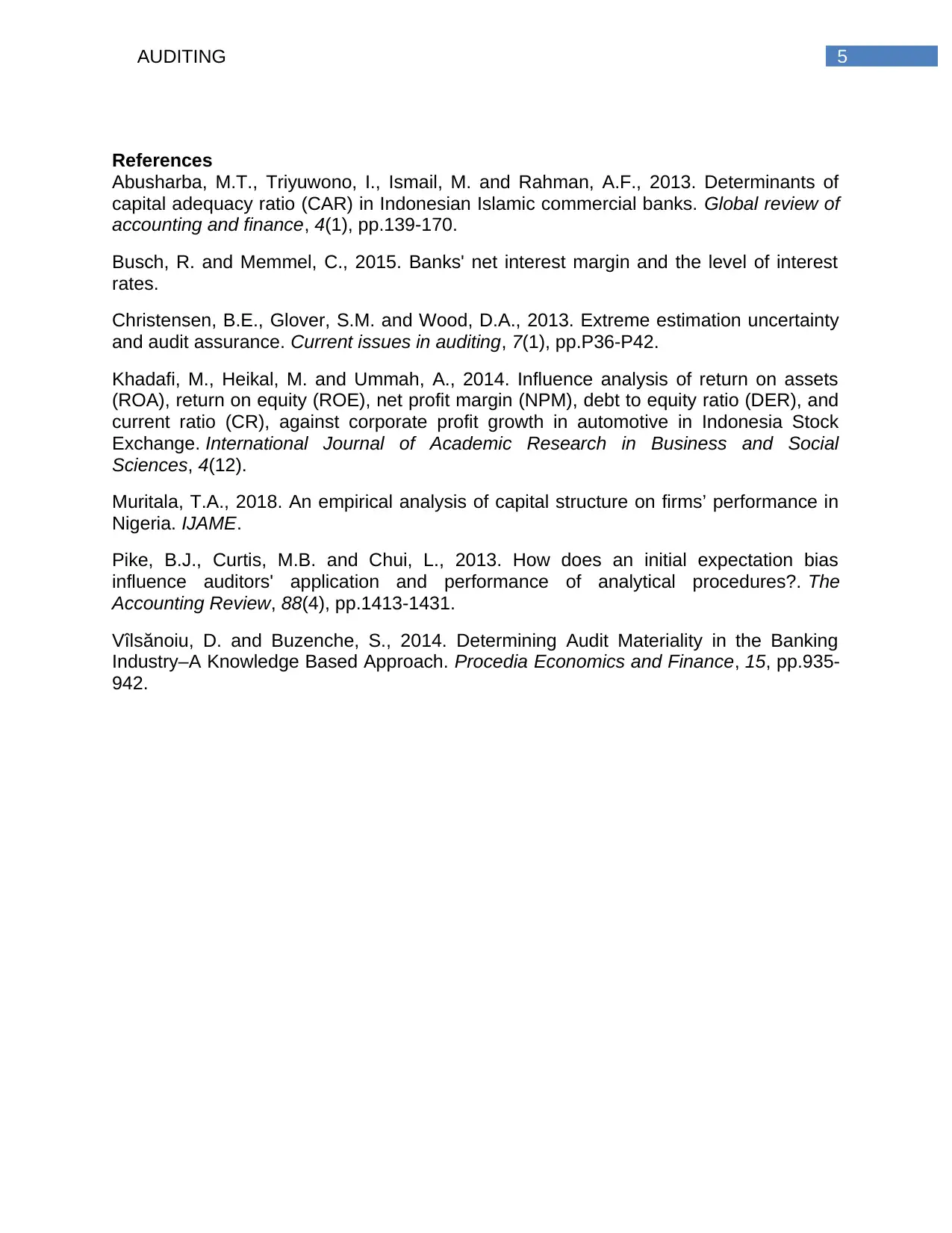
5AUDITING
References
Abusharba, M.T., Triyuwono, I., Ismail, M. and Rahman, A.F., 2013. Determinants of
capital adequacy ratio (CAR) in Indonesian Islamic commercial banks. Global review of
accounting and finance, 4(1), pp.139-170.
Busch, R. and Memmel, C., 2015. Banks' net interest margin and the level of interest
rates.
Christensen, B.E., Glover, S.M. and Wood, D.A., 2013. Extreme estimation uncertainty
and audit assurance. Current issues in auditing, 7(1), pp.P36-P42.
Khadafi, M., Heikal, M. and Ummah, A., 2014. Influence analysis of return on assets
(ROA), return on equity (ROE), net profit margin (NPM), debt to equity ratio (DER), and
current ratio (CR), against corporate profit growth in automotive in Indonesia Stock
Exchange. International Journal of Academic Research in Business and Social
Sciences, 4(12).
Muritala, T.A., 2018. An empirical analysis of capital structure on firms’ performance in
Nigeria. IJAME.
Pike, B.J., Curtis, M.B. and Chui, L., 2013. How does an initial expectation bias
influence auditors' application and performance of analytical procedures?. The
Accounting Review, 88(4), pp.1413-1431.
Vîlsănoiu, D. and Buzenche, S., 2014. Determining Audit Materiality in the Banking
Industry–A Knowledge Based Approach. Procedia Economics and Finance, 15, pp.935-
942.
References
Abusharba, M.T., Triyuwono, I., Ismail, M. and Rahman, A.F., 2013. Determinants of
capital adequacy ratio (CAR) in Indonesian Islamic commercial banks. Global review of
accounting and finance, 4(1), pp.139-170.
Busch, R. and Memmel, C., 2015. Banks' net interest margin and the level of interest
rates.
Christensen, B.E., Glover, S.M. and Wood, D.A., 2013. Extreme estimation uncertainty
and audit assurance. Current issues in auditing, 7(1), pp.P36-P42.
Khadafi, M., Heikal, M. and Ummah, A., 2014. Influence analysis of return on assets
(ROA), return on equity (ROE), net profit margin (NPM), debt to equity ratio (DER), and
current ratio (CR), against corporate profit growth in automotive in Indonesia Stock
Exchange. International Journal of Academic Research in Business and Social
Sciences, 4(12).
Muritala, T.A., 2018. An empirical analysis of capital structure on firms’ performance in
Nigeria. IJAME.
Pike, B.J., Curtis, M.B. and Chui, L., 2013. How does an initial expectation bias
influence auditors' application and performance of analytical procedures?. The
Accounting Review, 88(4), pp.1413-1431.
Vîlsănoiu, D. and Buzenche, S., 2014. Determining Audit Materiality in the Banking
Industry–A Knowledge Based Approach. Procedia Economics and Finance, 15, pp.935-
942.
⊘ This is a preview!⊘
Do you want full access?
Subscribe today to unlock all pages.

Trusted by 1+ million students worldwide
1 out of 6
Related Documents
Your All-in-One AI-Powered Toolkit for Academic Success.
+13062052269
info@desklib.com
Available 24*7 on WhatsApp / Email
![[object Object]](/_next/static/media/star-bottom.7253800d.svg)
Unlock your academic potential
Copyright © 2020–2025 A2Z Services. All Rights Reserved. Developed and managed by ZUCOL.



